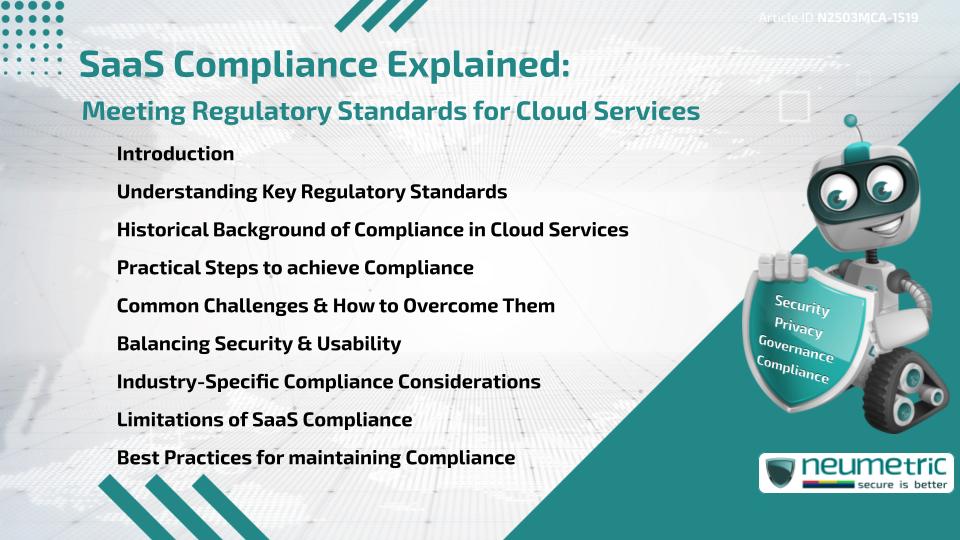Table of Contents
ToggleIntroduction
SaaS compliance explained is the process of ensuring that cloud-based software services meet all relevant legal, security & industry-specific regulations. From protecting Sensitive Data to following Privacy laws, compliance is vital for trust & operational success. This guide explores key standards, the history of compliance in cloud services, practical implementation steps, common challenges & Best Practices to help Organisations navigate the compliance landscape with confidence.
Understanding Key Regulatory Standards
At its core, SaaS compliance explained involves aligning a cloud service’s operations with legal frameworks such as the General Data Protection Regulation [GDPR], the Health Insurance Portability & Accountability Act [HIPAA], and the Payment Card Industry Data Security Standard [PCI DSS]. Each Framework governs how data is handled, stored & shared.
While GDPR focuses on Personal Data Protection in the European Union, HIPAA addresses Healthcare information in the United States & PCI DSS safeguards payment information worldwide. Compliance ensures a service provider is not only following the law but also it is earning Customer Trust.
Historical Background of Compliance in Cloud Services
Before cloud computing became mainstream, compliance efforts focused mainly on on-premises systems. With the rise of Software as a Service [SaaS] in the early 2000s, traditional compliance approaches needed to evolve. Data was no longer confined to a physical server room but spread across global data centers.
The need for modern frameworks grew, leading to the introduction & adaptation of regulations specifically addressing cloud-hosted data. SaaS compliance explained today is shaped by this shift from localized control to distributed responsibility.
Practical Steps to achieve Compliance
Achieving compliance involves several practical steps:
- Identify Applicable Regulations: Understand which laws & standards apply to your industry.
- Conduct a Gap Analysis: Compare current practices against regulatory requirements.
- Implement Security Measures: Use encryption, Access Controls & regular Audits.
- Document Policies: Maintain clear Policies for handling & protecting data.
- Train Employees: Ensure staff understand compliance obligations & Best Practices.
SaaS compliance explained in simple terms is about systematically closing the gap between where your organisation is & where it must be to meet regulations.
Common Challenges & How to Overcome Them
Compliance can be difficult due to changing regulations, complex technical requirements & resource constraints. Small Businesses often lack dedicated compliance teams, while there are larger Organisations that face challenges managing compliance across multiple regions.
Overcoming these hurdles requires investing in compliance management tools, engaging legal & Cybersecurity experts & creating a culture where compliance is seen as everyone’s responsibility.
Balancing Security & Usability
A common misconception is that compliance inevitably makes systems harder to use. While strong Security Measures can add steps for users, they do not have to harm usability. SaaS compliance explained in this context is about designing systems that are both secure & user-friendly — much like building a safe house with doors that lock but still open easily for the right people.
Industry-Specific Compliance Considerations
Different industries have unique Compliance Requirements. For example:
- Healthcare: HIPAA mandates strict Data Privacy for patient information.
- Finance: PCI DSS & the Sarbanes-Oxley Act [SOX] impose strict Audit & reporting requirements.
- Education: The Family Educational Rights & Privacy Act [FERPA] protects student data.
SaaS compliance explained varies significantly depending on the sector, making it essential for providers to tailor their strategies accordingly.
Limitations of SaaS Compliance
Compliance is not a guarantee of security. An organisation can meet all regulatory requirements yet still suffer a breach if controls are poorly implemented. SaaS compliance explained should be seen as a foundation — a necessary but not sufficient condition for protecting data.
Best Practices for maintaining Compliance
Maintaining compliance requires ongoing effort:
- Perform regular internal audits.
- Stay informed about Regulation updates.
- Review & update Security Measures periodically.
- Engage with industry forums & compliance communities.
When applied consistently, these practices keep Organisations aligned with evolving standards & strengthen Customer Trust.
Takeaways
- SaaS compliance explained covers aligning cloud services with relevant legal & Industry Standards.
- Regulations like GDPR, HIPAA & PCI DSS form the backbone of Compliance Requirements.
- Challenges include evolving regulations, resource limitations & balancing usability with security.
- Industry-specific rules demand tailored approaches.
- Compliance is an ongoing process, not a one-time achievement.
FAQ
What does SaaS compliance explained mean?
It means ensuring that a cloud-based software service meets legal, security & Industry Regulations.
Why is SaaS compliance explained important?
It protects Sensitive Data, meets legal obligations & builds Customer Trust.
Which regulations are part of SaaS compliance explained?
Common ones include GDPR, HIPAA, PCI DSS, SOX & FERPA depending on industry.
How does SaaS compliance explained affect Small Businesses?
Small Businesses may face resource challenges, but compliance helps them compete by proving reliability.
Can SaaS compliance explained guarantee security?
No, it reduces Risk but does not guarantee full protection.
Is SaaS compliance explained the same in every country?
No, regulations vary by jurisdiction & industry.
Need help?
Neumetric provides organisations the necessary help to achieve their Cybersecurity, Compliance, Governance, Privacy, Certifications & Pentesting goals.
Organisations & Businesses, specifically those which provide SaaS & AI Solutions, usually need a Cybersecurity Partner for meeting & maintaining the ongoing Security & Privacy needs & requirements of their Clients & Customers.
SOC 2, ISO 27001, ISO 42001, NIST, HIPAA, HECVAT, EU GDPR are some of the Frameworks that are served by Fusion – a centralised, automated, AI-enabled SaaS Solution created & managed by Neumetric.
Reach out to us!


